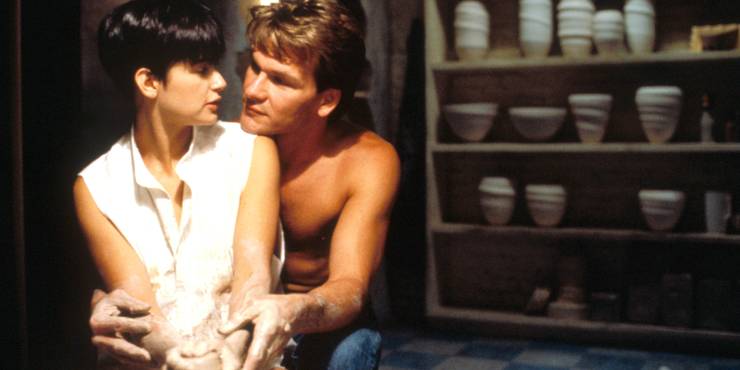15 Hollywood Movies You Didn’t Know Had Foreign Language Remakes

True or false: Hollywood, beneath all the flash and grandeur, is a capitalistic content mill, turning foreign film markets inside out to make profits off stories best left told in their native tongue. Generations-old oral histories are summarily butchered and re-packaged at the behest of a few greedy executives, and we, the over-consuming United Masses of America, are complicit in all of it.
Okay, that may be true, but pretty much every other national film industry does it, too.
Foreign-language filmmakers have been remaking Hollywood films for just as long as Hollywood has been doing the reverse. Some of these remakes are outright rip-offs, and some are properly licensed, local tailorings of Hollywood’s previous successes. Furthermore, the Hollywood movies that are remade vary from classics to what-the-hell?, and their foreign language counterparts take up the whole spectrum in quality, from utter trash to timeless trophies.
Here are 15 Hollywood Movies You Didn’t Know Had Foreign Language Remakes.
15 Blood Simple – A Simple Noodle Story (China, 2009)

What do you get when you cross American dark comedy genius with the lurid theatrics of Chinese wuxia cinema? 9 times out of 10, probably nothing you would want to watch. Unless of course you’re talking about director Zhang Yimou’s A Simple Noodle Story, a daring yet successful remake of the Coen Brothers’ Blood Simple. It’s no surprise Yimou’s oeuvre of Chinese fantasy-war films Hero, House of Flying Daggers, and most recently The Great Wall, has overshadowed his foray into the bizarre world of the Coen Brothers, but make no mistake: he can make a worthwhile Chinese CB film, too.
A Simple Noodle Story takes Blood Simple’s storyline and places it in historical Gansu, a desert province in China. Instead of cowboy hats and a cow-town bar, Yimou dresses his version with colorful robes and sets it in a small village noodle shop. Despite these elemental shits, Noodle Story preserves its spiritual kinship to the original – both films are comical treatments of a time and place well known to the collective conscious of their respective audiences. Where Yimou makes a real departure is in his tone; while Blood Simple is delivered with the classic deadpan style the Coen Brothers are now famous for, Yimou saturates his film in a brand of slapstick he felt better suited his Chinese audience.
14 Cellular – Connected (Hong Kong, 2008)

If you were to make a list of great Jason Statham movies, it’d probably look a little like this: TheTransporter, Crank, Snatch, Revolver, The Italian Job. Cellular probably wouldn’t even come to mind. But that’s exactly the film Warner Bros. chose as its first in a series of films it began remaking for Chinese audiences in the early 2000s. The resulting film, Connected, was released in 2008 through a joint venture between Warner Bros. and the Chinese state film bureau.
Benny Chan, a filmmaker heavily influenced by the Jackie Chan era of Hong Kong action films, was hired to rewrite and direct Connected. The remake stays relatively faithful to the original film’s basic premise, but was rewritten to allow more room for the kind of stunt work Hong Kong action films are best known for. Louis Koo, who has led a prolific career as an action film star in Hong Kong, takes on Statham’s original role and spices it up with some great stunt work and choreography.
13 Sideways – Saidoweizu (Japan, 2009)

Sideways is the wine-soaked cult-classic about a failed novelist named Miles (Paul Giamatti) who goes on a trip to the wineries of Santa Barbara County with his washed-up celebrity friend Jack Cole (Thomas Haden Church). It’s pensive and charming, and it earned director Alexander Payne and co-writer Jim Taylor the Academy Award for Best Adapted Screenplay in 2004.
Fox Japan and Fuji TV network got together to remake Sideways in 2009. Inexplicably, instead of shifting the setting to Japan, they just set the film a few hundred miles north of Santa Barbara wine country to Napa Valley. They also shifted other elements of the film, like the main character’s profession, from failed novelist to failed screenwriter. Don’t think too hard about it.
When asked to cameo in Saidoweizu, Paul Giamatti refused. When he was asked about the request, he told reporters, “they got a strange, little troll to play me.” Somewhere along the way, the irony of that statement was lost on him.
12 Unforgiven – Yurusarezaru Mono (Japan, 2013)

Unforgiven came in as number 6 in our list of the top 15 westerns of all time, so we have no qualms with Japan wanting to give it their own go, even if it is missing Clint Eastwood. The American Unforgiven was released in 1992, and it proved instrumental in revitalizing the modern Western, specifically revisionist Westerns.
Japan’s Unforgiven, which kept the same title, was made in 2013 and stays more or less faithful to the American version’s storyline; it follows a retired samurai as he re-enters a world of violence. It takes place in the Hokkaido frontier of the early Meiji period, which is essentially the Japanese equivalent of the American wild west. Hokkaido is the northernmost island in Japan and was one of the last regions to shift from feudal Japan to modern society at the turn of the 20th century. For those who need a cinematic reference, it takes place around the same time as The Last Samurai.
11 Ghost – Ghost: Mouichido Dakishimetai (Japan, 2010)

The most obvious difference between the original American romantic fantasty/drama Ghost, starring Demi Moore, Whoopi Goldberg, and Patrick Swayze, and Japan’s 2010 remake is this: in the Hollywood version, a man becomes a ghost and saves his wife from an imminent attack; in the Japanese version, the ghost is a woman who saves her husband. What the cultural objections were to having the man play the ghost in the remake is unclear.
The second most obvious difference is that one did really, really well in theaters, and the other did not. There are countless TV shows, movies, creatures, and comics that have originated in Japan and have either been remade or directly imported to America to widespread and unending success. Japanese producers Shochiku thought they were clever to try to reverse that formula. Instead, the Japanese version of Ghost has since become the single most compelling argument for keeping the hegemonic turnstile permanently rotating one way and not the other.
10 Reservoir Dogs – Kaante (India, 2002)

It took only ten short years for a foreign filmmaker to remake Reservoir Dogs, the movie that launched Quentin Tarantino’s career into the stratosphere. And it’s no surprise that Indian director Sanjay Gupta, who built most of his career remaking foreign films, was the one to do it with Kaante (after remaking Reservoir Dogs, Gupta went on to remake Park Chan-wook’s Oldboy). The finished product turned out to be a hit in India and abroad. Tarantino reportedly enjoyed the film, and found the remake flattering. One Indian reporter deemed it “the mother of all Bollywood action dramas.” That’s high praise considering how many films Bollywood puts out each year (in 2012 it was over three times that of the US’s output).
Of course, Gupta’s remake wasn’t the only thing Tarantino’s Reservoir Dogs inspired. In 2006, a video game of the same name was released for both the Xbox and Playstation 2. The third-person shooter was subsequently banned in Australia.
9 The Godfather – Sarkar (India, 2005)

It’s no wonder someone produced a foreign remake of Francis Ford Copolla’s 1972 classic The Godfather. 45 years later, The Godfather remains as quotable and iconic as it’s ever been, and still sits in the top 5 of the American Film Institute’s list of the 100 best movies of all time. But isn’t this exactly the reason not to remake it? It’s been done to perfection, so why touch it?
Sarkar takes the classic gangster epic and steeps it in the very real politics and crime of the Maharashtra region of western India. In giving the film a local spin, director Ram Gopal Varma succeeds in making the film entirely its own. It’s a true regional remake, making sense of the story and characters in terms of real events and political struggles that hit home for Maharashtrians. Although Varma’s remake doesn’t come anywhere near the masterfulness of the original film, it is widely considered to be, by both American and Indian critics alike, a feat of cinematic storytelling in its own right.
8 Italian Job – Players (India, 2012)

Players is the Indian remake of the Hollywood heist film The Italian Job, made jointly between the Hollywood media conglomerate Viacom and the Indian production company Motion 18. In a befitting twist, the Italian Job that the Indian Players is based off of is itself a remake of the 1969 British film of the same name, which stars the beloved Sir Michael Caine.
Players received mixed reviews but still ended up netting several million dollars. Virtually nobody in the US or the UK saw it (which is surprising considering how much Americans love remakes). The fact that the Fast and Furious franchise comes from a 1955 original film isn’t stopping Hollywood from making an 8th Fast and Furious film – they know people are still going to go see it. We should note that Players did, however, do relatively well in New Zealand, which happens to be where much of the movie was filmed.
7 Kramer vs. Kramer – Akele Hum Akele Tum (India, 1995)

Kramer vs. Kramer came out in 1979 to fervent critical praise for carefully dealing with divorce and custody arbitration without falling back on simple answers and cultural archetypes. It won five Academy Awards, made tens of millions of dollars of profit, and starred two of Hollywood’s all-time best leads, Meryl Streep and Dustin Hoffman.
Fifteen years later, Akele Hum Akele Tum was released in India to considerably less fanfare than the original, even while directly transcribing long stretches of text verbatim from the original English script. Maybe it was the change in the ending from an ambiguous, hard-thinking ending to – there’s no other way of putting this – a happy-go-lucky Hollywood ending. Somehow, though, the film still made more than its budget and managed to cast an actor who looks, well, like an Indian version of Dustin Hoffman (Indian superstar Aamir Khan). Despite the film’s lackluster response from audiences, it still managed to create a hit song in India, “Raja Ko Rani Se Pyar Ho Gaya”. Hit play and try your best not to wiggle along.
6 What Women Want – What Women Want (Hong Kong, 2011)

If you had the opportunity to bet money on the success of a rom-com about an advertising executive, played by a real-life film industry pariah, who falls into a bathtub with a hairdryer and subsequently gains the ability to read women’s thoughts, would you do it? Paramount Pictures did. And, somehow, they won big, raking in over $374 million worldwide for What Women Want, starring Mel Gibson and Helen Hunt. The film’s insane success solidified director Nancy Meyers’ career, who has since gone on to write and direct other box office hits like Something’s Gotta Give, It’s Complicated, and, most recently, The Intern.
The success of What Women Want led Chinese producers to remake the movie in 2011 (11 years after the Hollywood version), which also did fairly well, grossing nearly double its budget. It certainly didn’t hurt that two of China’s biggest stars, Andy Lau (a film star and arguably China’s best-known celebrity vocalist) and Gong Li (Memoirs of a Geisha, 2046, and Miami Vice, among many others), starred in the leading roles.
5 The Good, The Bad, and The Ugly – The Good, The Bad, The Weird (South Korea, 2008)

The Good, The Bad, and The Ugly is not only one of the most memorable (Spaghetti) Westerns of all time, it is also considered by many to be one of the best movies ever made. Featuring an all-star cast with Clint Eastwood in the lead, directed by the late great Sergio Leone, and employing the iconic melodies of Ennio Morricone, it had all the ingredients for enduring success, which it invariably achieved. Unsurprisingly enough, though, The Good is the second sequel to A Fistful of Dollars, which is a Western-genre remake of legendary Japanese director Akira Kurosawa’s samurai film Yojimbo. So, no, nothing is sacred.
Korean filmmaker Kim Jee-woon wrote and directed The Good, The Bad, The Weird as less of a remake and more of a belated, wonky homage to Leone’s classic. The film was sufficiently unique to become both a commercial and critical success in both South Korea and abroad. But the original Good, Bad, and Ugly was made long enough ago that it must qualify for a big-budget modern remake and not just a quirky retelling. Will somebody please get Wong Kar-wai on the phone and ask him to direct a wuxia remake?
4 Groundhog Day – Stork Day (Italy, 2004)

The Italian version of Groundhog Day is bad. Not bad in the way many comedies are bad: earnest, maybe even well made, but just not quite hitting that elusive bull’s-eye of memorable hilarity. It’s bad in a way that makes you both enraged and confused at how anybody could have spent time creating it.
Groundhog Day boasts that rare trifecta of great directing, sharp writing, and a nationally-beloved comedian’s charm (Bill, we love you). Stork Day‘s directing is inconsistent at best, and the Italian actor who replaces Murray (Antonio Albanese) is relatively unknown outside of his native country. However, StorkDay at least had the exact same success-proven screenplay to work from. And it even butchered that. The whole thing falls into that cruel and confusing category of remakes that has you thinking you must just be missing an inside joke – surely the creators were just massively trolling the rest of the world, right? Wrong, and in this case, it’s even worse than that time Limp Bizkit did a cover of The Who’s “Behind Blue Eyes”. Just… why?
3 Purple Rain – Akounak Tedalat Taha Tazoughai (Niger, 2015)

Purple Rain is the 1984 semi-autobiographical musical about pop-icon Prince that cemented the imagery and tone surrounding an entire sub-genre of rock music for generations to come. The film became an instant cult classic that people still watch today, presumably teary-eyed and bedridden, helplessly yearning for that perfect bygone union of grunge and glam (RIP Prince).
When filmmaker and ethnomusicologist Christopher Kirkley first thought to do a Purple Rain remake about the guitar-based music from East Africa’s Sahel region known as ishumar, it was sort of a joke between friends. It was just a thought-provoking, hypothetical way to eulogize an otherwise undocumented musical heritage that had until then been survived solely by cellphone recordings. Eventually, for Kirkley, the idea became more serious, and in 2015, he released his Tuareg version of Purple Rain to worldwide praise.
The film, while at first intended to be a somewhat faithful remake of Purple Rain, evolved into its own beast, as the actors and director altered lines and sequences to better fit the cultural context of the Sahel region. It still, however, retained the film’s original title, but with a Tuareg spin – Akounak Tedalat Taha Tazoughai – which translates, in absence of a Tuareg word for “purple,” to roughly “Rain The Color of Blue With a Little Rain In It.”
2 Assault on Precinct 13 – The Nest (France, 2002)

Maybe it’s because they think our films are vulgar atrocities, or perhaps it’s just because they have a perfectly thriving cinematic industry of their own, comprised of a large portion of the world’s all-time greats (like Godard, Truffaut, and Renoir), but the French don’t remake Hollywood films. One of the only exceptions, and for reasons nobody quite understands, is Assault on Precinct 13, a John Carpenter film produced in 1976 that at first entirely missed the attention of American audiences and critics, but over time, became a cult-classic in Europe.
A Hollywood remake of Precinct was produced in 2005 starring Ethan Hawke and Laurence Fishburne to a collective and unanimous “no thank you” from moviegoers. But three years before that remake, a French remake was made, called The Nest. The Nest’s Wikipedia page designates it a ‘quasi-remake’, but make no mistake: it is a full-on remake, and a pretty bad one at that. The French try so hard to separate themselves from the alleged heedless bilge that is Hollywood cinema, and they do a great job at it, but The Nest is one glaring exception, and it would be a disservice to let it go unnoticed.
1 The Proposal – The Proposal (India, 2012)/The Proposal (China, 2017)

The Proposal, starring Ryan Reynolds and Sandra Bullock – remember it? It’s about a book publisher’s assistant who is coerced into marrying his Canadian boss so she doesn’t get deported, and then actually falls in love with her. You may have seen it, you may not have, and there’s no real way of knowing because it’s entirely forgettable. Of course, this didn’t stop the public from going to see en masse: the movie grossed a whopping $317.4 million worldwide in 2009. What movie are we talking about again?
That monetary success, despite all its other qualities, has inexplicably led to not one but two foreign-language remakes in eight years. In 2012, not even three years after the Hollywood version came out, a Malayalam-language remake called My Boss (what a title change!) was released in India. Most recently, in June of 2016, Disney announced that it was teaming with Shanghai-based Linmon Pictures to produce a Chinese-language remake, which is currently in production. We can hardly wait.
—
What other well-known American films have been remade for foreign audiences? Let us know in the comments.
















